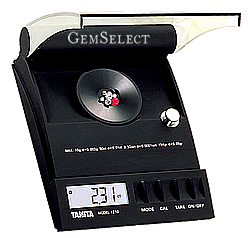Edelstein Karat GewichtDas Karatgewicht ist eine wichtige Qualität des Edelsteinwertes. Je größer der Stein, desto wertvoller ist er oft, da größere Steine sind weniger verbreitet. Es ist jedoch wichtig, sich daran zu erinnern, dass auch Qualitäten wie Farbe und Sättigung wichtig sind, um den Wert eines Steins zu bestimmen.  | | Edelstein-Karat-Waage |
Das englische Wort Karat kommt vom griechischen Wort für keration („kleines Horn“) und bezieht sich auf die Form der Samenkapseln des Johannisbrotbaums. Diese Samen sind klein und haben ein einheitliches Gewicht; Daher waren sie in frühen Zeiten ein Standard für das Wiegen von Edelsteinen. Um 1920 wurde das metrische Karat als internationaler Standard übernommen. Ein Karat entspricht einem Fünftel Gramm (0,20 Gramm), das Gramm entspricht also fünf Karat. Taverniers GesetzIm Allgemeinen steigt mit dem Karatgewicht eines Edelsteins auch der Preis pro Karat. Eine unterhaltsame Art, den Steinwert zu betrachten, ist die folgende: Seit dem späten 14. Jahrhundert gibt es ein Gesetz für Diamanten, das als "Indisches Gesetz" oder "Tavernier-Gesetz" bekannt ist: Gewicht² x C = Preis pro Stein Das Folgende zeigt, wie der Preis von a Diamant könnte sich mit dieser Formel erhöhen, die auf einen Grundpreis von 1000 USD pro Karat angewendet wird. | 